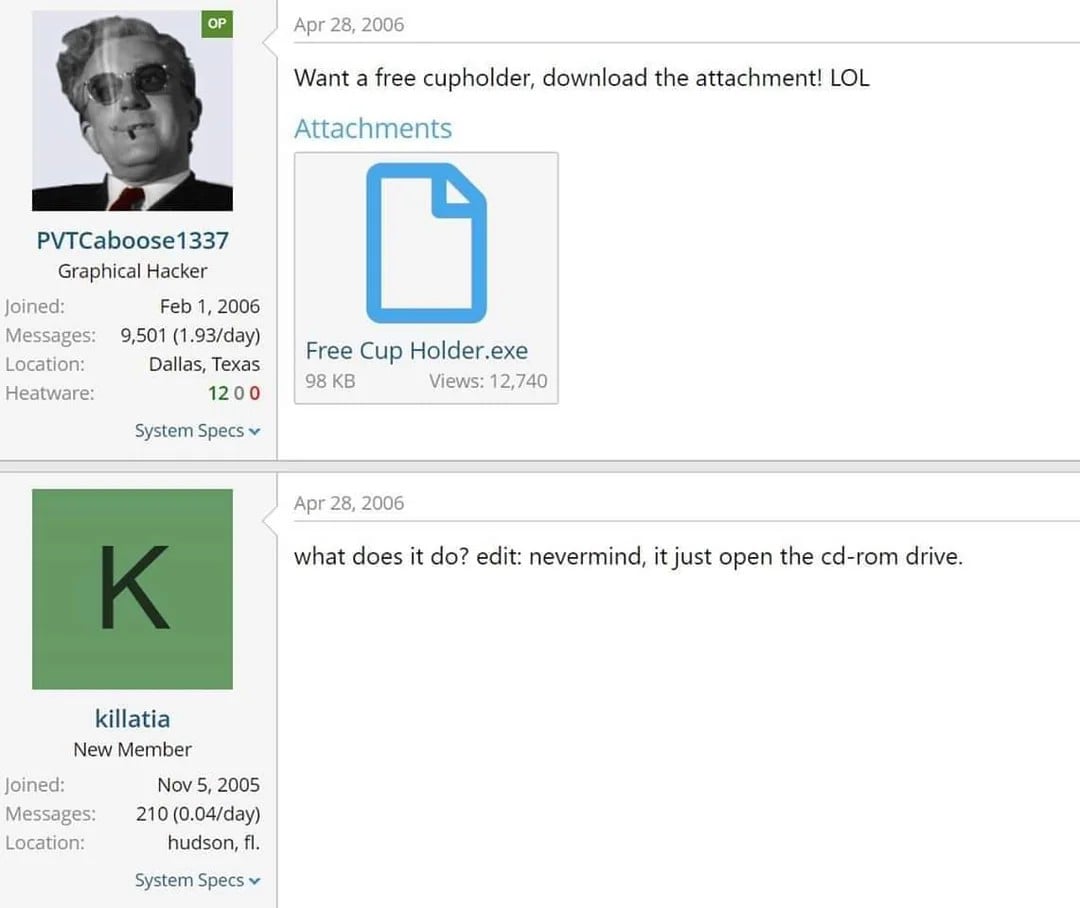I’ve been using linux for more than a decade at this point, but in all that time I’ve rarely had a disk drive. The fact that this command exists and is just, one of the core utils included with your distro along with su and kill and mount and more is just… so beautiful. 10 years amore with this OS and I’m still learning things that the elders in the audience are snickering at me for only learning 5 minutes ago while they were popping their disk trays open with a single command back when disk drives were a non optional component.
Very helpful command it was for those, whose modem had to be rebooted daily back in the day: Have a cron-job open the tray, which in turn was placed strategically so that it would hit the reset button of the modem, then close the tray. And voilà; automatic reboot of the modem. Robotics at its finest!
That is fantastic.
In the early 2000s, only my rich friends had cell phones. My roommate and I both had accounts on each other’s machines so we could telnet into them on the same local network.
We used to do this all the time to each other. It was funny to us 25 years ago. It’s still funny now.
This command was very useful for quickly finding a server in a row of hundreds of identical servers. No need to read the labels or look up which rack it’s in. Just log in remotely, just use ‘eject’, and then walk down the row to the server that has its tray out.
VPS providers hate this one trick
I was wondering why they still sold servers with disk drives
For deploying your sick playlist to production, obviously!
No not mine, thermal performance always goes haywire 😔
I haven’t worked in a data center in years, so I don’t know the current norm for server hardware.
Modern problems require modern solution.
Some CD trays will auto-close though.
The Dell servers we had at the time all had slim laptop style CD trays, so no auto-close to worry about.
Ah, the good old days of sshing into a family member’s computer and trolling them by constantly opening and closing the drive.
i envy you. lol
It it to wait 30 mins then do it every 10, and pop it in startup, those were the days.
The other was Free_Cupholder.EXE. I miss disk drives for this reason more than for actual use.
You mean the cup holder?
The finger guillotine.
Bologna storage.
You can configure sudo, used to elevate the privileges of a command, to insult users when they type in an incorrect password.
To do so, edit the sudoers file with a tool called visudo, which edits and validates modifications to the sudo configuration file.
sudo visudo
Near the top, add a line that reads:
Defaults insults
Save and close the file.
I found out about this recently and I love it. I don’t know why I like to be insulted, it makes me laugh.
I’m sure you do, you little scum! /s
Don’t ever match wits with a rutabaga
Back in networking classes we used to have entire rooms of replicated machines, all with contiguous addresses and same logins. We wrote a script to ssh into every computer of the room and eject and retract all the disk drives at the same time, it was wonderful ✨
You could’ve made music out of ejecting/retracting those all at different times!
Would’ve actually been fantastic distributed systems practice, synchronizing all of those to tight tolerances of music across a network connection…
Disk… drive?
what-year-is-it.jpeg
The year to backup (rip) your DVDs.
I long ago moved to a pair of 4TB hdds and recently upgraded to a pair of 16TBs
Oh boy I should’ve done it a long time ago.
tilts head
plugs in USB optical drive
ejectpop
hehe
push tray back in
ejectpop
hehehe
Almost 20 years ago I convinced my high school library to let me install Debian on one of the computer groups. I found the “eject” command, and wrote a script that just invoked it with an argument to close the tray. I named that script “inject”. Being high schoolers, my friends and I made scripts to “eject” and “inject”, along with various beeps, and named the scripts suggestive and tawdry things. We all had a good giggle setting the systems off on their little routines and walking away.
Eject is not just for CDs. You still have to eject any hot mount physical media. Sadly the eject command only works in some cases. I do not think it works for hot mount SATA dives for example.
I want it to work for all drives. Sometimes I just wanna launch my SSD across the room for shits and giggles, is there a bash command for that yet?
No, sadly not. Maybe it’s implemented in Fish?
Ooh, or maybe an oh-my-zsh plugin!

If you have a LS-120, it will eject the floppy disc like you were on dome fancy-pants Macintosh!
I’ve never encountered another LS-120 user before. When it came out I assumed it would be the future, because 120 megabyte freaking laser assisted floppy, am I right? Turns out I was very much mistaken, and CD-R took over.
I also made the same mistake regarding CF vs SD cards.
For the next storage revolution go with the opposite of your prediction maybe
I’m hoping for MacroSD. About the size of a 3.5" floppy so you won’t lose it easily.
Seriously, it’s interesting that now that we have the tech to make a useful-capacity storage device the size of a credit card, we don’t. Not like those crappy giveaway flash drives printed with a card design, where they had a captive USB head and were 4x as thick as a card, but something with just contacts like a chip card, so you might need to use an external reader but it really preserves the wallet-size concept.
I’d love to have a cheap 16GB card in my wallet with all my health records and a cryptographically signed copy of my will as a one-stop, no cloud required, emergency kit.
CF, or their follow-up CFast, are still in industrial PCs - at least in the Beckhoff IPCs my (ok, more like “my customers”) Automat is sporting
Used as system storage and easy to swap for the customer in regards of backups, if something breaks
120 MB? That’s more than a ZipDisk!
I knew I attended a well-funded modern college because all the computers had been upgraded with ZipDrives.
Yep, Zip drives only had 100MB, the disks were clunky and were prone to get the Click of Death (not that LS-120 disks were any better in that sense, of course).
They should make a usb-port with a spring in it which can be released with eject. Until then I have to be content with just making sound effects when I run eject on other devices.
I need to go put my DVD drive back in my tower to try this!
Those are discs not disks kiddo
I was wondering about OP’s soft-eject floppy drive. Seems quite retrofuturistic.
Macs had them, so they could control when the user was able to have their disk back 😅
There is a whole world of obsolete stuff nobody will ever do with a linux system anymore. Terminal servers with lots of serial terminals or modems for a BBS. Making a fax server, IVR, digital answering machine for analog land lines. Using removable optical or magnetic media. Recording broadcast tv. SCSI, Firewire. It is interesting to imagine what from today will be obsolete in a few years.
Magnetic media is still king of price to capacity (Hard drives) and I literally do still record broadcast television on one of my linux boxes















